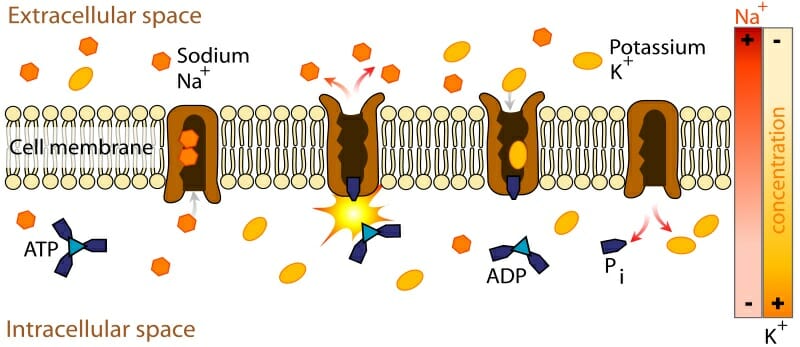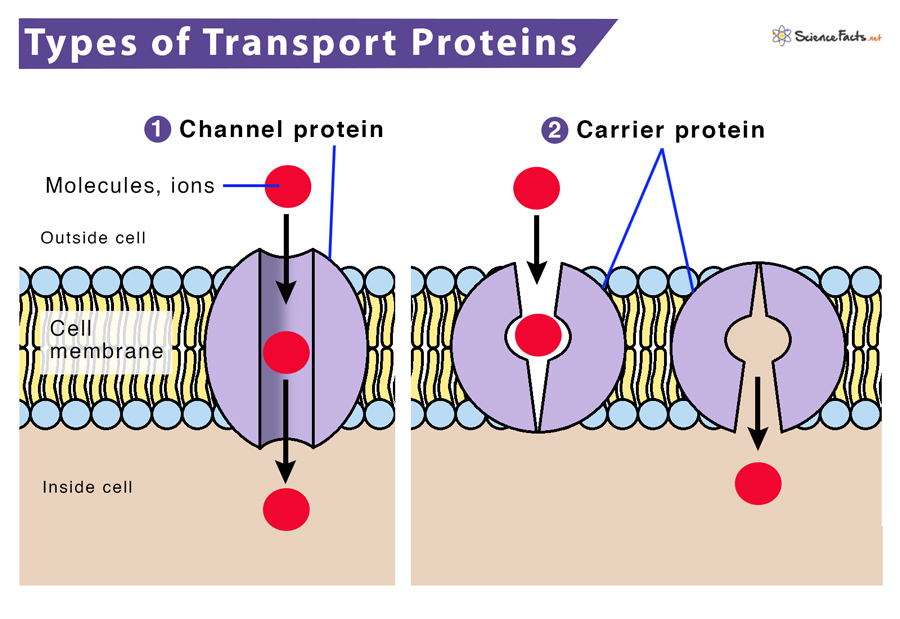These proteins basically allow passing polar molecules like ions sugars amino acids nucleotides and metabolites across the plasma membrane. Diffusion is the movement of a substance from an area of high concentration to one of low concentration.

Transport Proteins Definition Types Function Examples Video Lesson Transcript Study Com
In Activity 4 Active Transport two different types of transporter proteins were used the NaK transporter and glucose transporters.

. Active transport requires an expenditure of energy and a protein pump. The main difference between channel and carrier proteins is that channel proteins have a fixed conformation in the cell membrane whereas carrier proteins flip between two conformations while transporting. 1 Facilitated diffusion is specific since transport proteins only allow certain molecules or ions to pass 2 Facilitated diffusion rates are faster 3 Facilitated diffusion rates are saturable relies on a limited number of channels or transporters that can max out.
What about the glucose transporter. -Proteins may be attached to the inner surface of the plasma membrane. Transport proteins are often larger.
Channel and carrier proteins transport material at different rates. Channel proteins facilitate diffusion at a rate of tens of millions of molecules per second whereas carrier proteins work at a rate of a thousand to a million molecules per second. What is the difference between a transport protein and a channel protein.
There are two types of membrane transport proteins called channel proteins and carrier proteins. Carrier proteins and channel proteins which are implicated in the transport of water soluble and insoluble substances across the cell membrane. Cell Membrane And Transport Types Of Transporter Proteins Virtual Lab.
Differences - In passive mediated transport no energy is used by the cell and the molecules are moving with the concentration gradient. Explain your rationale for each. There are two types of transport protein carrier proteins and channelspores proteins Carrier proteins- These proteins are opened at one side of the membrane at a time because it allows the movement of substances against their concentration gradient.
Passive transport and active transport. Describe the two types of passive transport. Difference Between Channel And Carrier Proteins Characteristics Structure Role.
Transport proteins move large molecules from. -Some peripheral proteins are connected to. A computer-generated representation of a molecule of the hemoglobin-carrier of oxygen in blood a transport protein.
A vesicular transport protein is a transmembrane or membrane-associated protein. Plasma Membrane Gateway To The Cell Ation Biology. The basic function of both these proteins is to let polar molecules like ions amino acids sugar metabolites and nucleotides pass across the plasma membrane.
Transport proteins generally perform two types of transport. There are two types of membrane transport proteins. Though the function of both these proteins is same there are a number of differences.
Explain what kind of proteins are required for each type of passive transport and highlight the similarities and differences of these proteins. Transport proteins can only function via active transport. Explain your rationale for each.
Facilitated diffusion where a transport protein simply creates an opening for a substance to diffuse down its concentration gradient. Similarities - They both uses a helper protein to move the molecule. -The hydrophobic portion of a protein is embedded within the membrane.
When passive transport occurs molecules are moving from a concentrated area to a less concentrated area. Channel proteins gated channel proteins and carrier proteins are three types of transport proteins that are involved in facilitated diffusion. A membrane transport protein or simply transporter is a membrane protein that functions as such a carrier.
Transport proteins are often used by many substrates while channel proteins are generally used by ions. Passive transport and active transport. What Are The Diffe Types Of Transport Ponents Across Cell Membrane Quora.
Those that carry molecules to distant locations within a cell or an organism and those that serve as gateways carrying molecules across otherwise. In active transport energy is required and the molecules are moving against the concentration gradient. People also asked Study Guides.
Which of the following correctly identifies active transport. There are two different types of transport proteins. Draw label and describe a polarized transporting epithelial cell transporting glucose or amino acids Na K water.
Describe the two types of passive bartleby. Regulates or facilitates the movement of cellular content through vesicles. Channel and carrier proteins are two types of transport proteins found in the cell membrane which facilitate diffusion and active transport mechanisms.
Channel proteins transport much more quickly than do carrier proteins. Channel proteins are often larger than transport proteins. A channel protein a type of transport protein acts like a pore in the membrane that lets water molecules or small ions through quickly.
Up to 10 cash back There are two types of transport. Differentiate between the different types of protein-mediated transport and diagram the mechanisms of each including the general energy requirements. And active transport where the cell expends energy in order to move a substance against its concentration gradient.
Include the direction of movement and relevant membrane proteins ions and concentration gradients. Transport proteins move large molecules from areas of low. Was the NaK transporter used in active carrier-mediated transport or facilitated diffusion.
Passive transport includes simple diffusion and facilitated diffusion. There is regular passive transport and there is facilitated diffusion in which particles are guided through proteins channels into the cell. There are two main kinds of cellular transport.

Transport Protein Definition Function Types Examples Biology Dictionary
Difference Between Channel And Carrier Proteins Difference Between


0 Comments